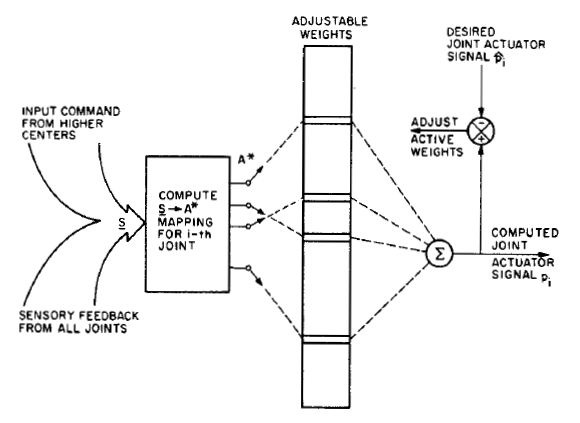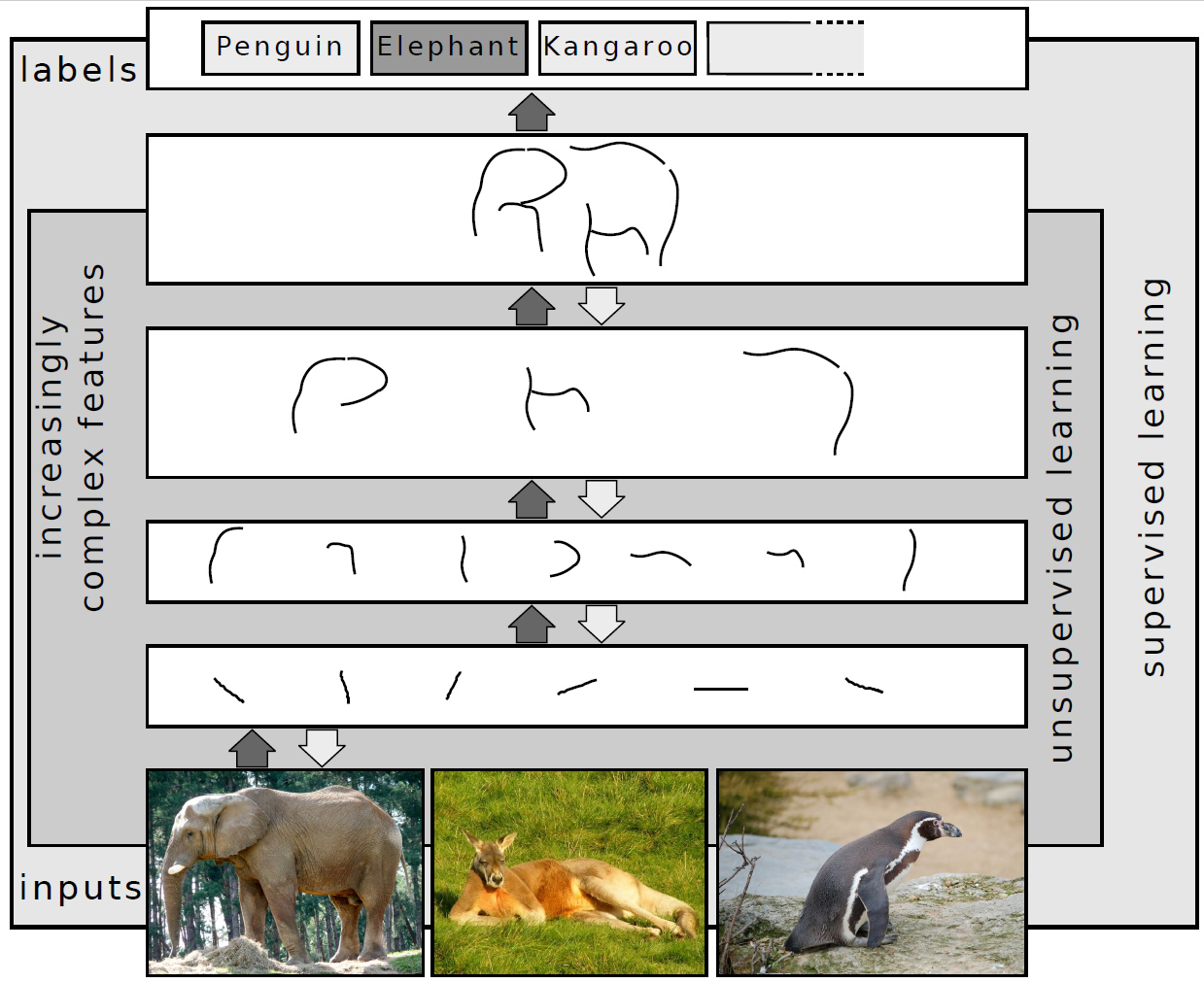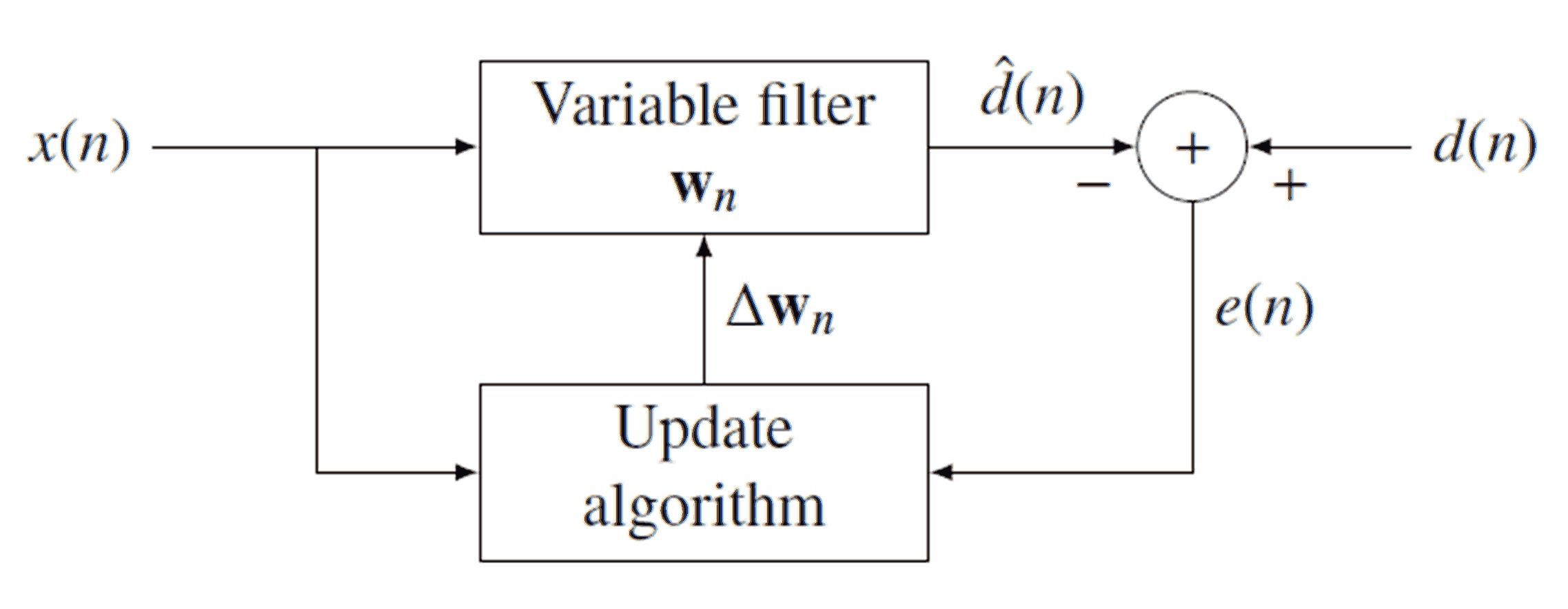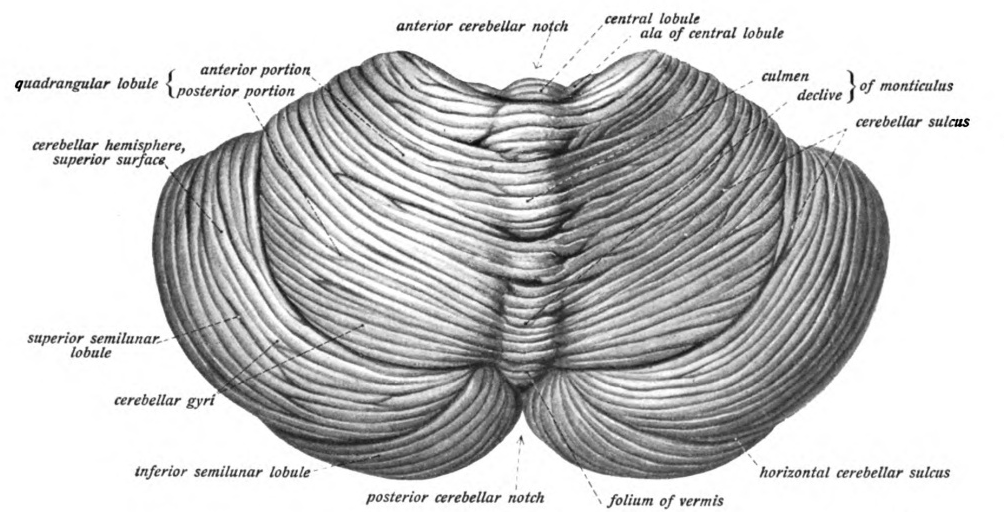 |
Cerebellar Model Articulation Controller
The cerebellar model arithmetic computer (CMAC) is a type of neural network based on a model of the mammalian cerebellum. It is also known as the cerebellar model articulation controller. It is a type of associative memory. The CMAC was first proposed as a function modeler for robotic controllers by James Albus in 1975 (hence the name), but has been extensively used in reinforcement learning and also as for automated classification in the machine learning community. The CMAC is an extension of the perceptron model. It computes a function for n input dimensions. The input space is divided up into hyper-rectangles, each of which is associated with a memory cell. The contents of the memory cells are the weights, which are adjusted during training. Usually, more than one quantisation of input space is used, so that any point in input space is associated with a number of hyper-rectangles, and therefore with a number of memory cells. The output of a CMAC is the algebraic sum of the weig ... [...More Info...] [...Related Items...] OR: [Wikipedia] [Google] [Baidu] |
|
Artificial Neural Networks
In machine learning, a neural network (also artificial neural network or neural net, abbreviated ANN or NN) is a computational model inspired by the structure and functions of biological neural networks. A neural network consists of connected units or nodes called '' artificial neurons'', which loosely model the neurons in the brain. Artificial neuron models that mimic biological neurons more closely have also been recently investigated and shown to significantly improve performance. These are connected by ''edges'', which model the synapses in the brain. Each artificial neuron receives signals from connected neurons, then processes them and sends a signal to other connected neurons. The "signal" is a real number, and the output of each neuron is computed by some non-linear function of the sum of its inputs, called the '' activation function''. The strength of the signal at each connection is determined by a ''weight'', which adjusts during the learning process. Typically, neur ... [...More Info...] [...Related Items...] OR: [Wikipedia] [Google] [Baidu] |
|
|
Computational Neuroscience
Computational neuroscience (also known as theoretical neuroscience or mathematical neuroscience) is a branch of neuroscience which employs mathematics, computer science, theoretical analysis and abstractions of the brain to understand the principles that govern the development, structure, physiology and cognitive abilities of the nervous system. Computational neuroscience employs computational simulations to validate and solve mathematical models, and so can be seen as a sub-field of theoretical neuroscience; however, the two fields are often synonymous. The term mathematical neuroscience is also used sometimes, to stress the quantitative nature of the field. Computational neuroscience focuses on the description of biologically plausible neurons (and neural systems) and their physiology and dynamics, and it is therefore not directly concerned with biologically unrealistic models used in connectionism, control theory, cybernetics, quantitative psychology, machine le ... [...More Info...] [...Related Items...] OR: [Wikipedia] [Google] [Baidu] |
|
 |
Deep Learning
Deep learning is a subset of machine learning that focuses on utilizing multilayered neural networks to perform tasks such as classification, regression, and representation learning. The field takes inspiration from biological neuroscience and is centered around stacking artificial neurons into layers and "training" them to process data. The adjective "deep" refers to the use of multiple layers (ranging from three to several hundred or thousands) in the network. Methods used can be either supervised, semi-supervised or unsupervised. Some common deep learning network architectures include fully connected networks, deep belief networks, recurrent neural networks, convolutional neural networks, generative adversarial networks, transformers, and neural radiance fields. These architectures have been applied to fields including computer vision, speech recognition, natural language processing, machine translation, bioinformatics, drug design, medical image analysis, c ... [...More Info...] [...Related Items...] OR: [Wikipedia] [Google] [Baidu] |
 |
Recursive Least Squares Filter
Recursive least squares (RLS) is an adaptive filter algorithm that recursively finds the coefficients that minimize a weighted linear least squares cost function relating to the input signals. This approach is in contrast to other algorithms such as the least mean squares (LMS) that aim to reduce the mean square error. In the derivation of the RLS, the input signals are considered deterministic, while for the LMS and similar algorithms they are considered stochastic. Compared to most of its competitors, the RLS exhibits extremely fast convergence. However, this benefit comes at the cost of high computational complexity. Motivation RLS was discovered by Gauss but lay unused or ignored until 1950 when Plackett rediscovered the original work of Gauss from 1821. In general, the RLS can be used to solve any problem that can be solved by adaptive filters. For example, suppose that a signal d(n) is transmitted over an echoey, noisy channel that causes it to be received as :x(n)=\sum_^ ... [...More Info...] [...Related Items...] OR: [Wikipedia] [Google] [Baidu] |
 |
Artificial Neural Network
In machine learning, a neural network (also artificial neural network or neural net, abbreviated ANN or NN) is a computational model inspired by the structure and functions of biological neural networks. A neural network consists of connected units or nodes called '' artificial neurons'', which loosely model the neurons in the brain. Artificial neuron models that mimic biological neurons more closely have also been recently investigated and shown to significantly improve performance. These are connected by ''edges'', which model the synapses in the brain. Each artificial neuron receives signals from connected neurons, then processes them and sends a signal to other connected neurons. The "signal" is a real number, and the output of each neuron is computed by some non-linear function of the sum of its inputs, called the '' activation function''. The strength of the signal at each connection is determined by a ''weight'', which adjusts during the learning process. Typically, ne ... [...More Info...] [...Related Items...] OR: [Wikipedia] [Google] [Baidu] |
|
Hash Function
A hash function is any Function (mathematics), function that can be used to map data (computing), data of arbitrary size to fixed-size values, though there are some hash functions that support variable-length output. The values returned by a hash function are called ''hash values'', ''hash codes'', (''hash/message'') ''digests'', or simply ''hashes''. The values are usually used to index a fixed-size table called a ''hash table''. Use of a hash function to index a hash table is called ''hashing'' or ''scatter-storage addressing''. Hash functions and their associated hash tables are used in data storage and retrieval applications to access data in a small and nearly constant time per retrieval. They require an amount of storage space only fractionally greater than the total space required for the data or records themselves. Hashing is a computationally- and storage-space-efficient form of data access that avoids the non-constant access time of ordered and unordered lists and s ... [...More Info...] [...Related Items...] OR: [Wikipedia] [Google] [Baidu] |
|
 |
Cerebellum
The cerebellum (: cerebella or cerebellums; Latin for 'little brain') is a major feature of the hindbrain of all vertebrates. Although usually smaller than the cerebrum, in some animals such as the mormyrid fishes it may be as large as it or even larger. In humans, the cerebellum plays an important role in motor control and cognition, cognitive functions such as attention and language as well as emotion, emotional control such as regulating fear and pleasure responses, but its movement-related functions are the most solidly established. The human cerebellum does not initiate movement, but contributes to motor coordination, coordination, precision, and accurate timing: it receives input from sensory systems of the spinal cord and from other parts of the brain, and integrates these inputs to fine-tune motor activity. Cerebellar damage produces disorders in fine motor skill, fine movement, sense of balance, equilibrium, list of human positions, posture, and motor learning in humans. ... [...More Info...] [...Related Items...] OR: [Wikipedia] [Google] [Baidu] |
 |
Perceptron
In machine learning, the perceptron is an algorithm for supervised classification, supervised learning of binary classification, binary classifiers. A binary classifier is a function that can decide whether or not an input, represented by a vector of numbers, belongs to some specific class. It is a type of linear classifier, i.e. a classification algorithm that makes its predictions based on a linear predictor function combining a set of Weighting, weights with the feature vector. History The artificial neuron network was invented in 1943 by Warren McCulloch and Walter Pitts in ''A Logical Calculus of the Ideas Immanent in Nervous Activity, A logical calculus of the ideas immanent in nervous activity''. In 1957, Frank Rosenblatt was at the Cornell Aeronautical Laboratory. He simulated the perceptron on an IBM 704. Later, he obtained funding by the Information Systems Branch of the United States Office of Naval Research and the Rome Air Development Center, to build a custom- ... [...More Info...] [...Related Items...] OR: [Wikipedia] [Google] [Baidu] |